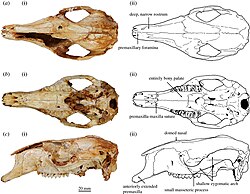| Congruus Temporal range: | |
|---|---|
 | |
| Skull of Congruus kitcheneri | |
| Scientific classification | |
| Domain: | Eukaryota |
| Kingdom: | Animalia |
| Phylum: | Chordata |
| Class: | Mammalia |
| Infraclass: | Marsupialia |
| Order: | Diprotodontia |
| Family: | Macropodidae |
| Subfamily: | Macropodinae |
| Genus: | † Congruus McNamara, 1994 |
| Species | |
| |
Congruus is an extinct genus of macropod known from the Late Pleistocene of Australia. There are two species, Congruus kitcheneri, which was originally described as a species of Wallabia, [1] [2] and Congruus congruus. [3] Specimens are known from Mammoth Cave, Western Australia, the Thylacoleo Caves (Nullarbor Plain) and the Naracoorte caves in South Australia. [2] [3] Potential material is also known from Eastern Australia. [2] The morphology of the skull and limbs suggests that they were semi-arboreal browsers, moving slowly through trees, though they were larger than and not as specialised for climbing as living tree kangaroos. [2] They are thought to be members of the tribe Macropodini, and close relatives of the extinct genus Protemnodon . [4]